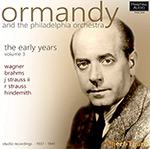
This album is included in the following sets:
This set contains the following albums:
- Producer's Note
- Full Track Listing
- Cover Art
Leopold Stokowski left a formidable legacy of Wagner recordings during the years of his directorship of the Philadelphia Orchestra, enough to fill more than four CDs; so it is rather surprising that Ormandy’s 10-inch disc of Meistersinger excerpts presented here is his only example of orchestral Wagner on record during this period, although he also provided several vocal accompaniments for Flagstad and Melchior.
Ormandy had first recorded the Brahms Second Symphony with the Philadelphians anonymously for the World’s Greatest Music series nine months before the version presented here (to be released in Volume 5 of this series). The earlier version was on ten sides, while this one was on twelve, like the 1929 Stokowski version (reissued on Pristine PASC 562) it was intended to replace. Apparently, this was not due to a more expansive interpretation; indeed, according to Richard Kaplan’s Philadelphia Orchestra discography, the 12-sided version is 11 seconds faster than the ten-sided one. Victor’s decision made the set rather uncompetitive in a field which otherwise had ten- or even eight-sided Brahms Seconds. (Interestingly, the earlier version was reissued on RCA’s Camden LP series, the only World’s Greatest Music release to be so chosen.)
Ormandy had already recorded a best-selling album of Johann Strauss overtures and waltzes with the Minneapolis Symphony before setting down the three waltzes heard here. While he remade the Emperor Waltz ten years later for a Columbia LP, the other two had to wait until the stereo era for another Ormandy/Philadelphia version. Richard Strauss’ Rosenkavalier Waltzes had also already been set down by Ormandy in Minneapolis on three ten-inch sides. Here, he was able to take advantage of longer recording times to re-record it on a single 12-inch disc.
Hindemith’s Mathis der Maler Symphony was a mere six years old when Ormandy made the recording included here. It was only the second version on disc, following the composer’s own 1934 recording; and the two would go on to become the only sets available during the 78 rpm era. As so often when they were playing what was then “new music”, Ormandy and his Philadelphians bring an almost missionary zeal to the performance, which blazes with intensity, particularly in the brass.
For his first Richard Strauss tone poem on disc, Ormandy chose the then lesser-known Symphonia Domestica for what became its first electrical recording. (There had been a late acoustic set with Eduard Mörike; and the only other 78-era recording would be Carl Schuricht’s version from three years later, on PASC 320.) For the next couple years, Ormandy would be Victor’s “go-to” conductor for Strauss tone poems, setting down Ein Heldenleben in 1939 (in Volume 1 of our series, PASC 578) and Don Quixote with Feuermann the following year (PASC 168). While he continued to record and re-record most of the major Strauss orchestral works until the end of his career, he never returned to the Domestica, leaving this his sole statement on the work.
Mark Obert-Thorn
Eugene Ormandy and The Philadelphia Orchestra: The Early Years ∙ Volume 3
CD 1
WAGNER
Die Meistersinger von Nürnberg
(Act 3)
1. Dance of the Apprentices (2:59)
2. Entrance of the Mastersingers (3:12)
Recorded 9 January 1937 ∙ Matrices: BS 03192-2 & 03193-1 ∙ First issued
on Victor 1807
BRAHMS Symphony No. 2 in D major, Op. 73
3. 1st Mvt. – Allegro non troppo (14:01)
4. 2nd Mvt. – Adagio non troppo (10:38)
5. 3rd Mvt. – Allegretto grazioso (5:29)
6. 4th Mvt. – Allegro con spirito (9:15)
Recorded 21 December 1939 and *27 March 1940 ∙ Matrices: CS 045653-1,
045654-1, 045655-1, 045656-2, 045657-1, 045658-1. 045659-1, *045660-3,
045661-2, 045662-2, 045663-1 & 045664-1 ∙ First issued on Victor
17302/7 in album M-694
7.
J. STRAUSS II Wiener Blut (Vienna Blood) - Waltz, Op. 354
(5:02)
Recorded 15 March 1941 ∙ Matrices: CS 062561-1 ∙ First issued on Victor
18060
8.
J. STRAUSS II Frühlingsstimmen (Voices of Spring) - Waltz Op. 410
(5:00)
Recorded 15 March 1941 ∙ Matrices: CS 062560-1 ∙ First issued on Victor
18060
9. J. STRAUSS II Kaiser-Walzer (Emperor Waltz), Op. 437
(10:04)
Recorded 1 August 1941 ∙ Matrices: CS 062562-3 & 062563-4A ∙ First
issued on Victor 18220
CD 2
HINDEMITH Symphony “Mathis der Maler”
1. 1st Mvt. – Engelkonzert (Ruhig bewegt) (7:35)
2. 2nd Mvt. – Grablegung (Sehr langsam) (4:08)
3. 3rd Mvt. – Versuchung des heiligen Antonius (Sehr langsam frei im
Zeitmaß – Sehr lebhaft) (11:46)
Recorded 20 October 1940 ∙ Matrices: CS 056578-1, 056579-1A, 056580-1,
056581-1A, 056582-1A & 056583-1 ∙ First issued on Victor 18333/5 in
album M-854
4. R. STRAUSS Waltzes from Der Rosenkavalier (10:14)
Recorded 25 October 1941 ∙ Matrices: CS 071208-1 & 071209-1A ∙ First
issued on Victor 18390
R. STRAUSS Symphonia Domestica, Op. 53
5. Thema I (Bewegt) (0:56)
6. Thema II (Sehr lebhaft) (2:05)
7. Thema III (Ruhig) (1:45)
8. Scherzo (Munter) (5:54)
9. Mässig langsam (Wiegenlied) (5:33)
10. Adagio (Langsam) (10:57)
11. Finale (Sehr lebhaft) (12:29)
Recorded 9 May 1938 ∙ Matrices: CS 022364-3, 022365-3, 022366-3, 022367-1,
022368-1, 022369-3, 022370-3, 022371-3, 022372-2A & 022373-1 ∙ First
issued on Victor 15225/9 in album M-520
Eugene Ormandy ∙ The Philadelphia Orchestra
Producer and Audio Restoration Engineer: Mark Obert-Thorn
Special thanks to Nathan Brown, Richard Kaplan and Charles Niss for
providing source material
All recordings made in the Academy of Music, Philadelphia
Cover artwork based on a photograph of Eugene Ormandy from the Tully Potter Collection
Total duration: 2hr 19:12
CD1: 65:44 CD2: 73:28

